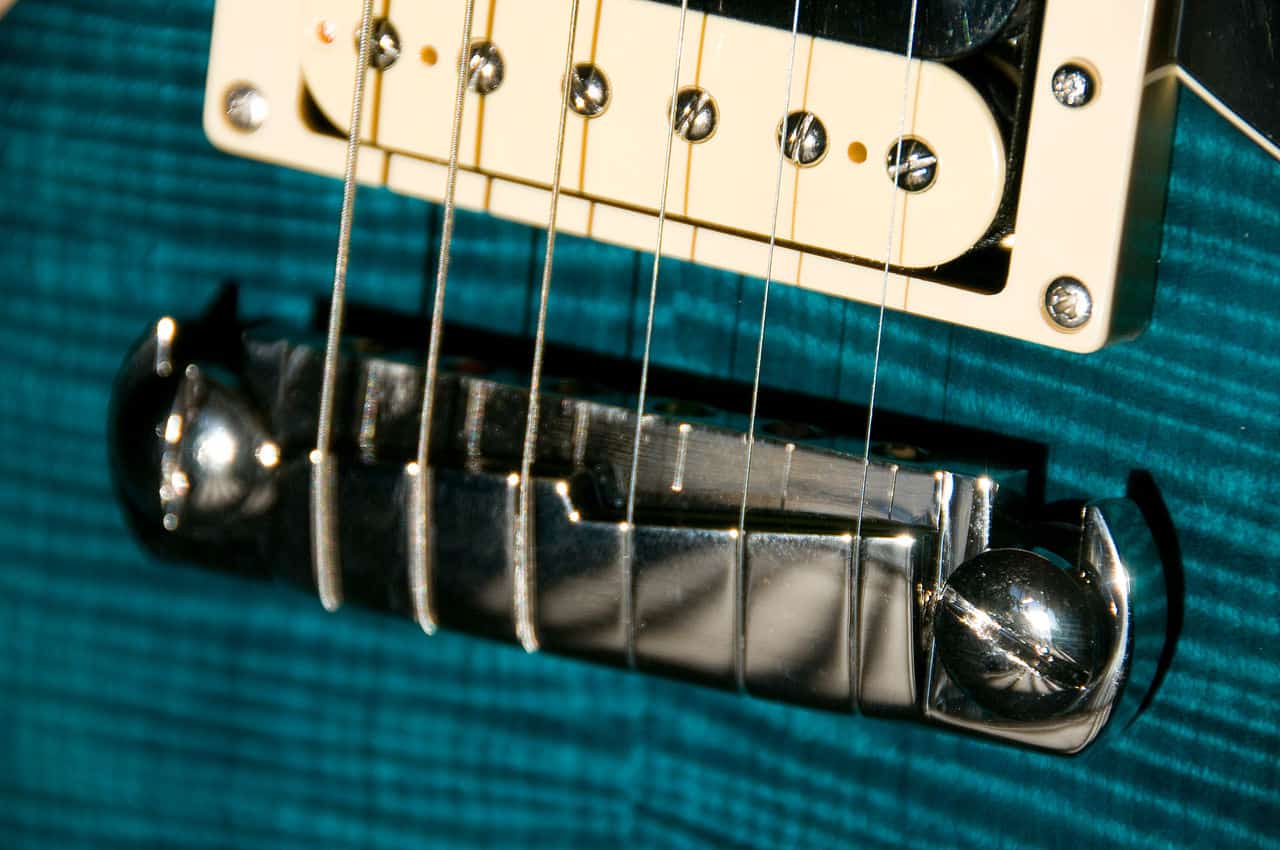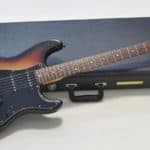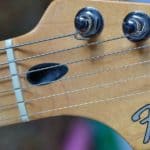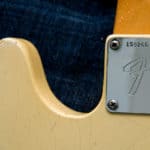The bridge of a guitar might be more important than you think.
There are many different bridges out there, and making sense of them is a duty only for the nerdiest of guitar geeks.
But don’t worry, I’ve got you covered.
First of all, if you were asking yourself if the bridge of a guitar does have any effect on its tone, here is a short answer:
The bridge of a guitar is where the strings meet the body and will have an effect on its tone. However, this effect is rather mild and probably not all players would notice any difference when switching between similar types. Being this said, a completely different kind of bridge will sound different.
If you want to stick with me for a bit longer, in this article I will tell you how and how much bridges affect tone.
After that, I will talk briefly about the most popular models you might find around there.
Finally, I will answer some frequently asked questions about guitar bridges and give you my conclusions and recommendations on them.
Are you ready to get started?
Let’s go!
Does a guitar’s bridge affect its tone?
The bridge is a fundamental part of the guitar since is the medium via which the strings meet the body. Every part of the instrument will have an impact on its final timbre, however, the bridge’s contribution to the tone is rather small. With the exception of switching from radically different bridge types.
And by these radical differences, I mean going from a hardtail bridge to a floating tremolo system.
In that particular case, the springs will probably take some resonance from the guitar’s body and affect the tone and sustain.
Perceiving these subtle changes, however, is in most cases only for the most experienced players and in controlled environments.
I bet your average audience member wouldn’t even notice the change in tone from a guitar switch mid show.
How much does a guitar’s bridge affect its tone?
Quantifying the impact of a bridge in a guitar’s tone is not an easy task, and it would require extensive scientific testing to determine, with statistical significance, that there is an effect whatsoever.
What I can offer you are some empirical evidence and my opinion. I hope that works out for you today.
If you think of an instrument’s tone being the result of the subtraction every single component makes from the “original” string tone, you can easily think of each of these parts as being EQ filters.
Some will have a deeper impact on the frequencies they take from, others less so.
Bridges are not as defining as tonewoods or pickups, however, it’s certain that different models will have different masses and ways of interacting with the strings, thus resulting in varying overall timbres.
My final conclusion on this topic is that the effect will be mild, but if you could test for it and listen carefully, you will probably hear it.
Why are guitar bridges important?
A guitar’s bridge is most important for various reasons, mostly related to the playability of the instrument.
Here are 4 reasons why guitar bridges are fundamental:
- Intonation: By adjusting the bridge you can correct problems related to intonation, fret buzz, and dead frets
- Action: This is the height of the strings relative to the fretboard, and this is controlled mainly by the bridge
- Alignment: The bridge acts as a guide for the strings to procure they line up perfectly with the pickups, for instance
- Tremolo: Last but not least, some bridges will allow you to alter the pitch of the sound the instrument is producing by loosening the strings temporarily
Most common types of guitar bridges and their effect on tone
Now that we have a broad understanding of the importance and effect of bridges, it is time to look into some of the most popular iterations of them.
In no particular order, here are some of the most common types of guitar bridges, how they work, and their effect on tone:
Tune-O-Matic
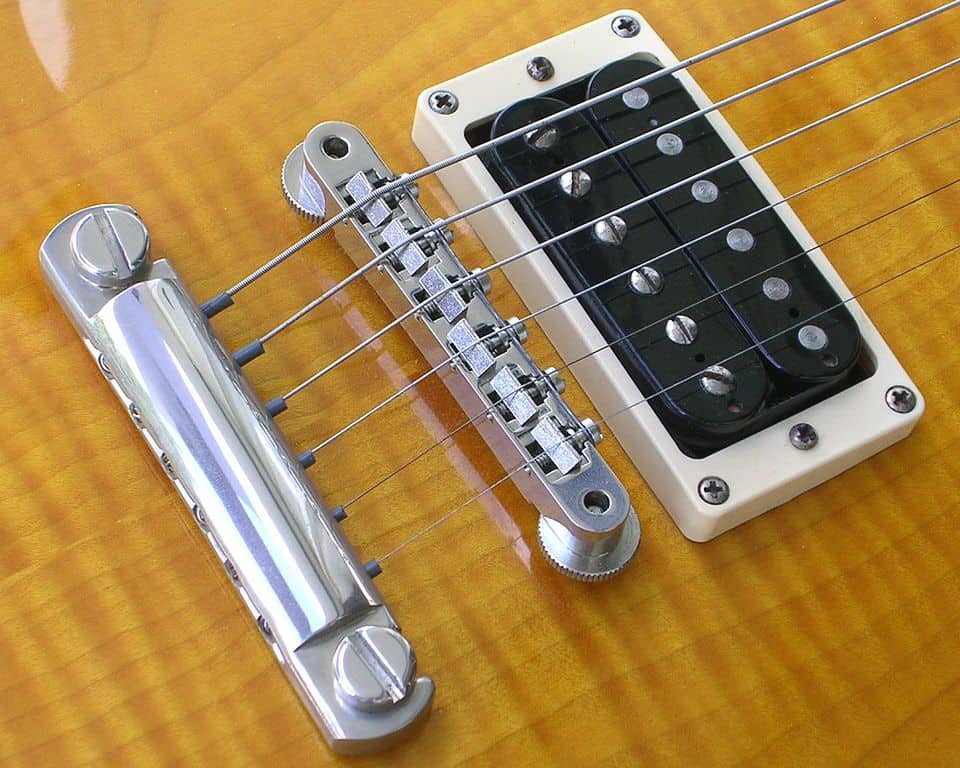
The Tune-O-Matic is a fixed bridge commonly used in Les Pauls. It consists of 2 parts, a saddle and a tailpiece that’s located further down the body.
This kind of bridge gives the string a strong grounding with the body of the instrument, helping sustain and resonance.
Its design, without going into technical detail, bolsters tuning stability and makes it easy to work with when adjustments are required.
Wrap-Around
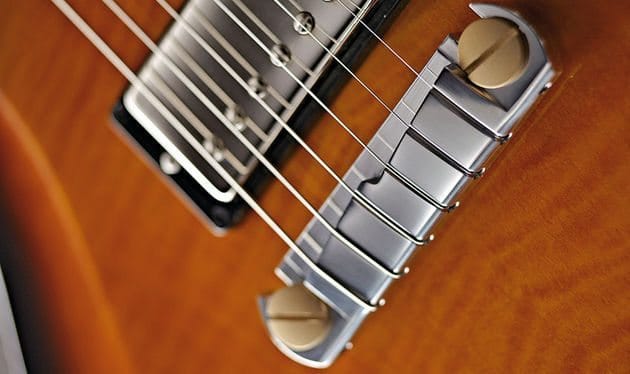
The Wrap-Around bridge, as its name implies is designed so the strings can pass through it, thread inside it from above, and wrap around the tailpiece while strings rest over the saddles.
This is also a fixed bridge, and it combines both saddle and tailpiece into one unique component.
As with every other fixed bridge, this design improves sustain and resonance.
The process of changing strings is very easy, but, in some models, fine-tuning intonation is not possible.
Hardtail
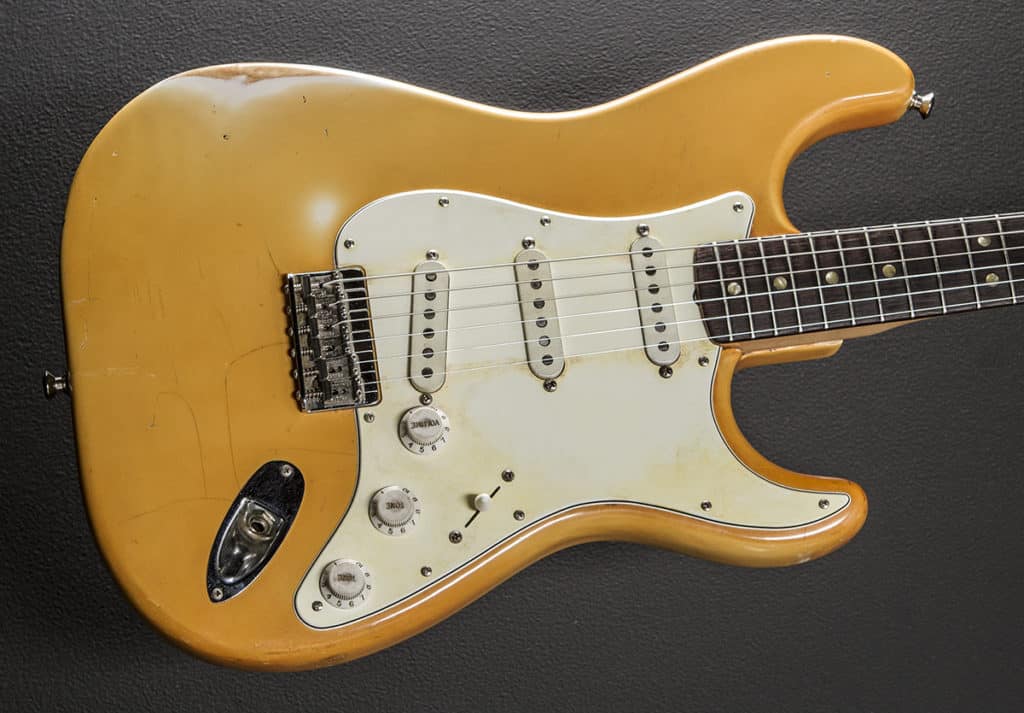
The Hardtail bridge is popular among Fender guitars. This is another instance of a fixed bridge and another approach to its design.
In this iteration, strings entre from the back of the guitar’s body and are threaded through holes smaller than their ball ends which keeps them in place. After being secured, they loop over the saddle.
As with every other fixed bridge, resonance and sustain are great.
Hardtail bridges tend to hold tuning fairly well, their restringing process is accessible, and are easy to work with.
Synchronized tremolo
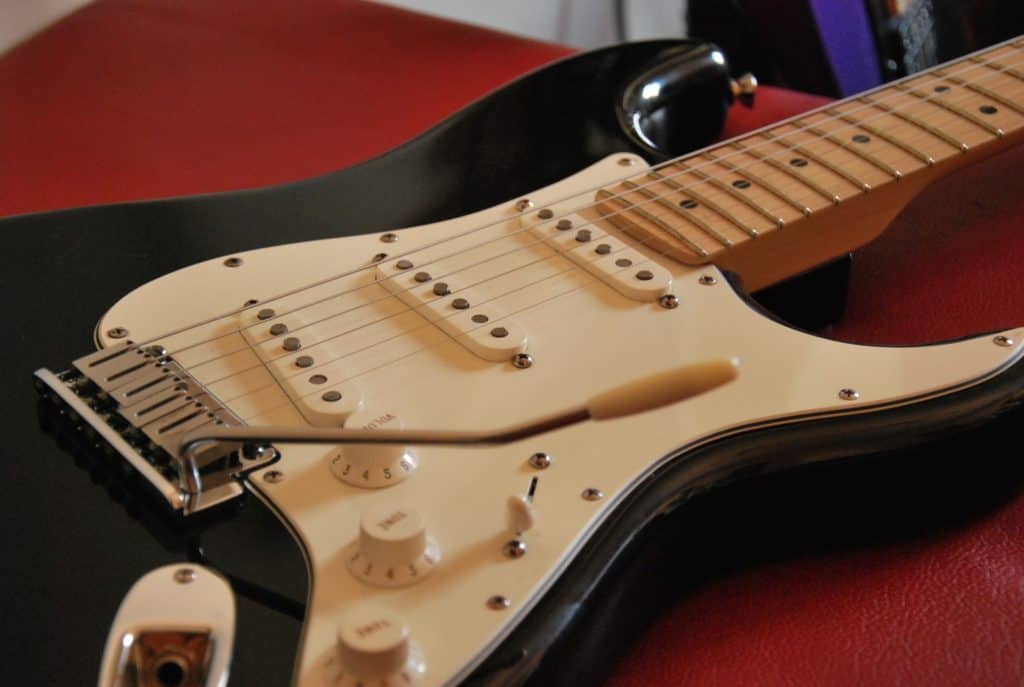
The Synchronized tremolo bridge is the other Fender most common alternative. This is a floating bridge.
This system is a bit more complicated: Strings enter the guitar from the back of the body and are anchored to a piece called the “block”. This block is held by usually 3 or 5 springs designed to be balanced with the string’s tension.
Strings come out on the front and loop over the saddles as usual, but the tailpiece as a whole has usually 2 or 6 pivot points in which it rests when force is applied via the whammy bar, which acts as a lever, raising (or lowering) the front of the system.
Floating bridges tend to take away resonance and sustain from the instrument.
In terms of tuning and intonation, moving parts are not beneficial. There are more points of failure and places where some friction can retain the string and alter its tension.
Floyd Rose
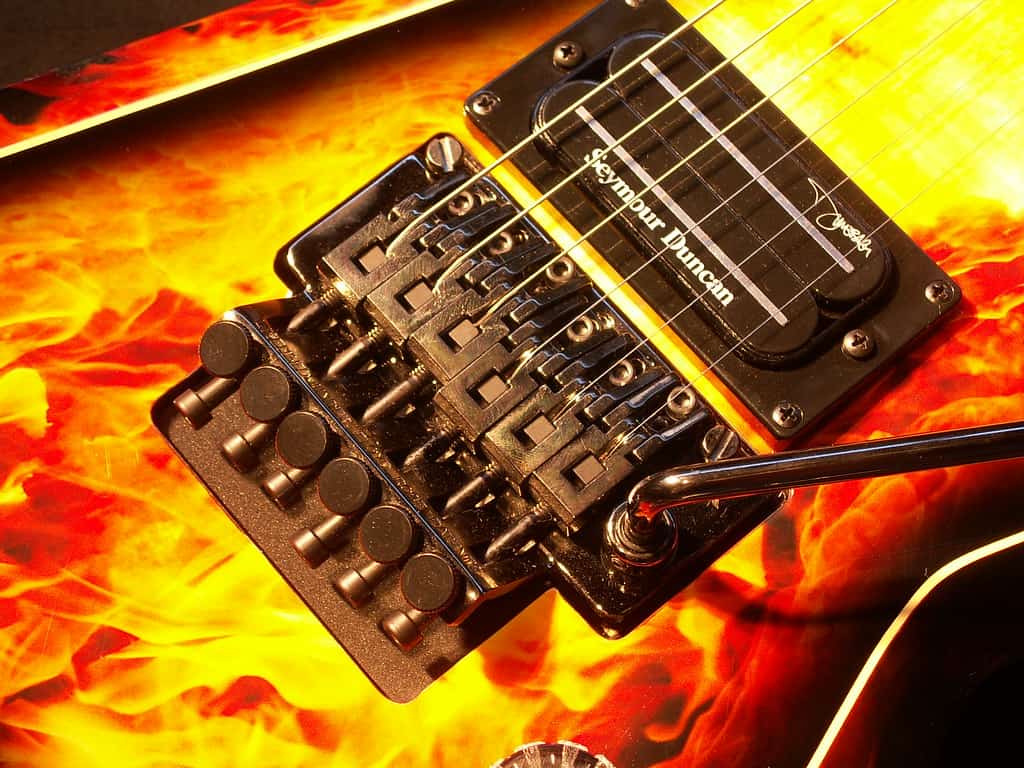
The Floyd Rose is a floating bridge turned up to 11. It was designed to work against the main “flaws” of its synchronized alternative.
In this bridge, strings are usually required to lose their ball ends and are held by screws at the saddles. The whole system floats with a series of springs that are inside the instrument’s body.
As a way to compensate for tuning issues caused by the friction the strings generate when going through the nut, Floyd Rose systems usually incorporate a locking nut that clamps the strings in place at that point and renders the tuning heads unusable.
To give the player a way to still control the tension of the strings, in many models of this contraption you will find small fine tuners on the bridge itself.
This iteration is probably the most extreme of the floating bridges and it allows the player to go crazy with the whammy bar with no consequences in tuning.
The cost of this advantage is reduced sustain, resonance, and a very complex setup experience.
Stetsbar
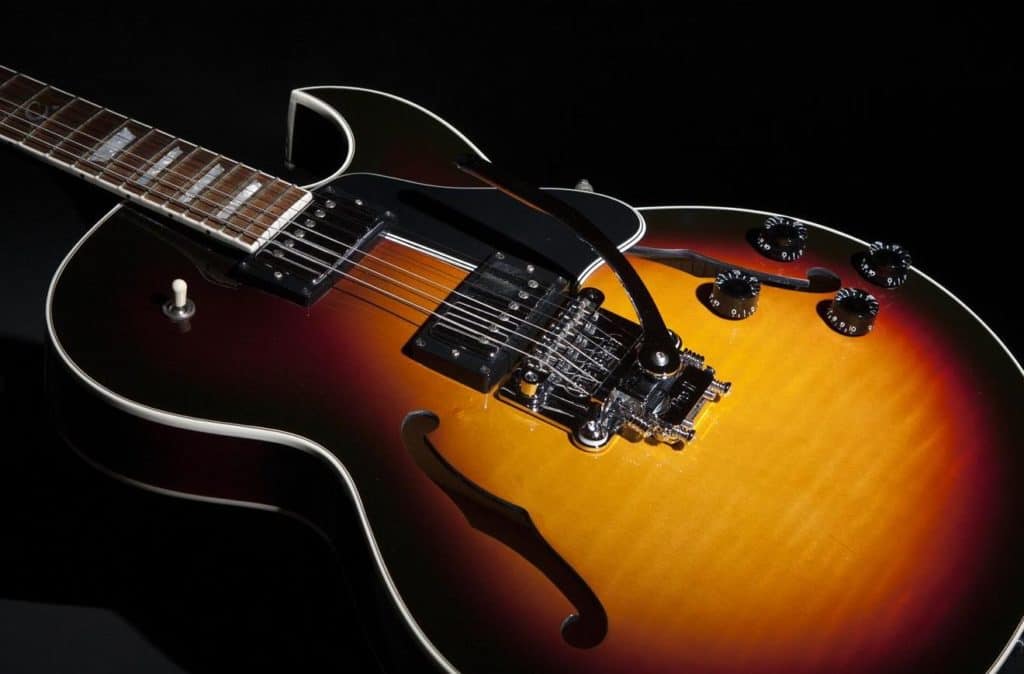
The Stetsbar is a kind of floating bridge designed to convert Tune-O-Matic fitted guitars into tremolo-capable instruments.
Its main point is that you don’t need to make any modifications to the guitar to install it.
The string’s pull is held in equilibrium by 2 heavy-duty springs anchored to the back of the unit’s base plate.
When the vibrato bar is moved, the bridge operates with a linear motion in the same plane as the guitar strings.
As with every other floating bridge, springs take from the resonance and sustain of the instrument.
Tuning stability is acceptable, but more complexity is added and makes for fine-tuning operations take more time.
Does the bridge affect intonation?
A guitar’s bridge is one of the defining factors of the instrument’s overall intonation. Firstly high action might cause the strings to bend when fretted, hence modifying their pitch. Also, bridges have actually intonation pieces controlled by adjustable screws that need to be set up correctly.
Does the bridge affect playability?
The bridge of a guitar will allow you to adjust string height, a defining factor for the instrument’s playability and feel. This is called string action and will depend on the player’s preference, as long as it doesn’t generate any problems such as fret buzz.
Does string height affect tone?
String height or action can affect tone, although slightly. Higher strings will make for the instrument to sound more “open” since the extra distance from the frets will allow them to resonate fully and even increase sustain. On the other said, extremely low action will prevent this and generate fret buzz.
Conclusions and recommendations
Whether you are looking for a new guitar or planning on building or having one built, getting to know, at least at a high level how bridges work is, in my opinion, something that will help you make a better informed final decision.
However, here in GearAficionado, I always say that you should try out every instrument before buying it if you have the chance.
I don’t think anyone can really understand the sound of all these different bridges without getting to hear them live. At least try the ones that you think might work out better for you.
If it’s within your reach, try to get to play completely different guitars to clearly understand where the variation lies, and then start checking out ones closer to the one you preferred the most.
Finally, don’t forget to have fun. Technicalities for some people get the joy out of getting a new piece of gear. You don’t have to know it all about something that makes you smile. Just go and play the instrument that feels best to you.

Hello there, my name is Ramiro and I’ve been playing guitar for almost 20 years. I’m obsessed with everything gear-related and I thought it might be worth sharing it. From guitars, pedals, amps, and synths to studio gear and production tips, I hope you find what I post here useful, and I’ll try my best to keep it entertaining also.

